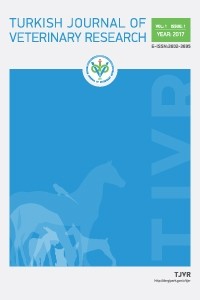Detection of extended-spectrum β-lactamase (ESBL) producing Escherichia coli in chickens
Detection of extended-spectrum β-lactamase (ESBL) producing Escherichia coli in chickens
Objective: Indiscriminate use of antibiotics in poultry farms increases the chance of antibiotic-resistant and ESBL producing bacteria in Bangladesh. Therefore, the study was undertaken to detect the extended-spectrum β-lactamase (ESBL) producing Escherichia coli (E. coli) in chickens.
Materials and methods: A total of 60 cloacal swab samples (20 from commercial layer, 20 from commercial broiler, and 20 from commercial Sonali chickens) were collected from the Rajshahi district of Bangladesh. The E. coli was isolated from these samples and identified based on cultural, staining, and biochemical characteristics. The disk diffusion method was used to assay the antibiotic-resistant/sensitivity patterns of the isolated E. coli. Phenotypic detection of ESBL producing E. coli was also done.
Results: The prevalence of E. coli in chickens was 61.67% in the Rajshahi district of Bangladesh, where the prevalence was 60%, 60%, and 65% in a commercial layer, commercial broiler, and commercial Sonali chickens, respectively. The antibiotic sensitivity assay of E. coli isolated from commercial layer chickens showed 100%, 80%, 50%, 40%, and 40% resistant to amoxicillin, tetracycline, cefotaxime, ciprofloxacin, and ceftazidime, respectively. E. coli isolated from commercial broiler chickens showed 100%, 100%, 60%, 50%, and 40% resistant to amoxicillin, tetracycline, cefotaxime, ceftazidime, and ciprofloxacin, respectively. E. coli isolated from commercial Sonali chickens showed 90%, 70%, 50%, 50%, and 40% resistant to amoxicillin, tetracycline, cefotaxime, ciprofloxacin, and ceftazidime, respectively. In phenotypic detection, the overall prevalence of ESBL producing E. coli was 43.33%, where 40%, 50%, and 40% in the commercial layer, commercial broiler, and commercial Sonali chickens, respectively in the Rajshahi district of Bangladesh.
Conclusion: These results indicated that chickens are a potential reservoir for ESBL producing E. coli and their antibiotic resistances are obviously significant. These findings will help us to make a proper guideline for the treatment, prevention, and control of E. coli prevalent in chickens in Bangladesh
Keywords:
Chickens, E. coli, Prevalence, Antibiotic resistance, ESBL,
___
- Ahoyo AT, Baba-Moussa L, Anago AE, Avogbe P, Missihoun TD, Loko F, et al. Incidence of Infections due to Escherichia coli Strains Producing Extended-Spectrum Beta-lactamase, in the Zou/Collines Hospital Centre (CHDZ/C) in Benin. Med Mal Infect. 2007;37(11):746-52.
- Anago E, Fanou LA, Akpovi CD, Hounkpe WB, Agassounon M, Tchibozo D, et al. Antibiotic Resistance and Genotype of Beta-lactamase-producing Escherichia coli in Nosocomial Infections in Cotonou, Benin. Ann Clin Microbiol Antimicrob. 2015;14(5):1-6.
- Bauer AW, Kirby WM M, Sherris JC, Turck M. Antibiotic Susceptibility Testing by A Standardized Single Disk Method. Am J Clin Pathol. 1966;45(4):493-6.
- Canton R, Coque TM. The CTX-M β-lactamase Pandemic. Curr Opin Microbiol. 2006;9(5):466-75.
- Charles HB, Mandal S, Hayer S, Sran M, Zehra A, Sunny JP, et al. The Prevalence of Extended-Spectrum Beta-Lactamase-Producing Multidrug-Resistant Escherichia coli in Poultry Chickens and Variation According to Farming Practices in Punjab, India. Environ Health Perspect. 2017;125(7):7701-10.
- Clinical and Laboratory Standards Institute (CLSI). Performance standards for antimicrobial susceptibility testing; 26th ed. CLSI supplement M100S, Wayne, Pennsylvania, USA. 2016.
- Costa D, Vinue L, Poeta P, Coelho AC, Matos M, Saenz Y, et al. Prevalence of Extended-Spectrum Beta-Lactamase-Producing Escherichia coli Isolates in Fecal Samples of Broilers. Vet Microbiol. 2009;138(3-4):339-44.
- Hadiujjaman M, Rahman MM, Ahasan MD, Banu AM, Khatun M, Alimul M. Isolation and Identification of Escherichia coli from Apparently Healthy Chickens of Selected Areas of Bangladesh. IJNSS. 2016;3(3):15-23.
- Hasan B, Sandegren L, Melhus A, Drobni M, Hernandez J, Waldenstrom J, et al. Antimicrobial Drug-Resistant Escherichia coli In Wild Birds and Free-Range Poultry, Bangladesh. Emerg Infect Dis. 2012;18(12):2055-8.
- Jacoby GA, Munoz-Price LS. The New β-lactamases. N Engl J Med. 2005;352:380-91.
- Jorgensen JH, Turnidge JD. Susceptibility test methods: dilution and disk diffusion methods Manual of clinical microbiology. 11th ed. American Society for Microbiology, Washington, DC. 2015.
- Kashyap G, Gupta S, Mamoria VP, Durlabhji P, Jain D. Increasing Prevalence of Extended-Spectrum Beta-Lactamases (ESBL) Producing E. coli and Klebsiella spp. in Outpatient Departments (Opds) Patients in Urinary Tract Infections (Utis) in Tertiary Care Hospital. Int J Cur Res. 2013;5(11):87-93.
- Mohanty S, Gaind R, Ranjan R, Deb M. Use of the Cefepime-Clavulanate ESBL E Test for Detection of Extended-Spectrum Beta-Lactamases in Ampc Co-Producing Bacteria. J Infect Dev Ctries. 2010;4(1):24-9. Moyo SJ, Aboud S, Kasubi M, Lyamuya EF, Maselle SY. Antimicrobial Resistance Among Producers and Non-Producers of Extended-Spectrum Beta-Lactamases in Urinary isolates at a Tertiary Hospital in Tanzania. BMC Res Notes. 2010;348:1-5.
- Muvunyi CM, Masaisa F, Bayingana C, Mutesa L, Musemakweri A, Muhirwa G, et al. Decreased Susceptibility to Commonly Used Antimicrobial Agents in Bacterial Pathogens Isolated From Urinary Tract Infections in Rwanda: The Need For New Antimicrobial Guidelines. Am J Trop Med Hyg. 2011;84(6):923-8.
- Paterson DL, Bonomo RA. Extended-Spectrum Beta-Lactamases: A Clinical Update. Clin Microbiol Rev. 2005;18(4):657-86.
- Başlangıç: 2017
- Yayıncı: Ebubekir CEYLAN
Sayıdaki Diğer Makaleler
Researching some mineral substance and vitamin levels in the cattle with indigestion
Detection of extended-spectrum β-lactamase (ESBL) producing Escherichia coli in chickens
Wahidur RAHMAN, Md. HOSSAİN, Md. ALİ, Tania SULTANA, K. M. Mozaffor HOSSAIN
Burcu GÖKDEMİREL, Zeynep BOZKAN
Investigation of The Effect of Aminoglycosides on Angiotensin Converting Enzyme (ACE)
Sevim ÇİFTÇİ YEGİN, Yeter DEĞER, Semiha DEDE, Fatmagül YUR
Miray ÇINAR, Buğrahan Bekir YAĞCI
Treatment of Humerus Salter Harris Type II Fracture with Double Pin Combination
